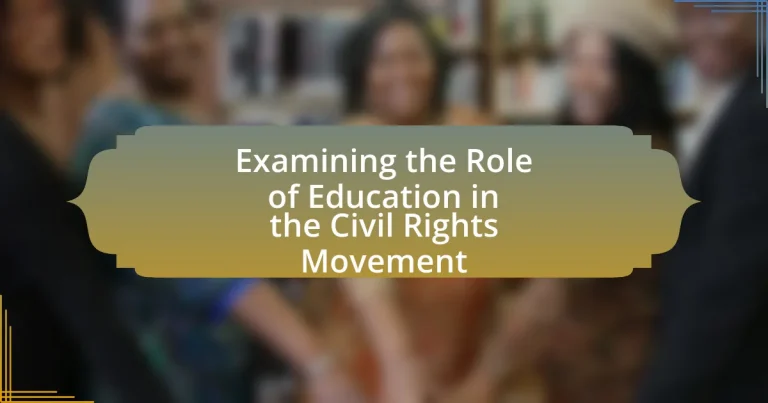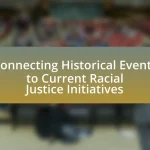The article examines the critical role of education in the Civil Rights Movement, highlighting how it empowered African Americans and served as a catalyst for social change. It discusses the significance of historically Black colleges and universities (HBCUs) in fostering leadership and activism, as well as the impact of educational initiatives like Freedom Schools in promoting civil rights awareness. Key legal milestones, such as the Brown v. Board of Education decision, are analyzed for their effects on desegregation and educational equality. The article also explores the ongoing challenges in education that reflect historical disparities and the lessons learned from past educational efforts in advocating for social justice and equality.
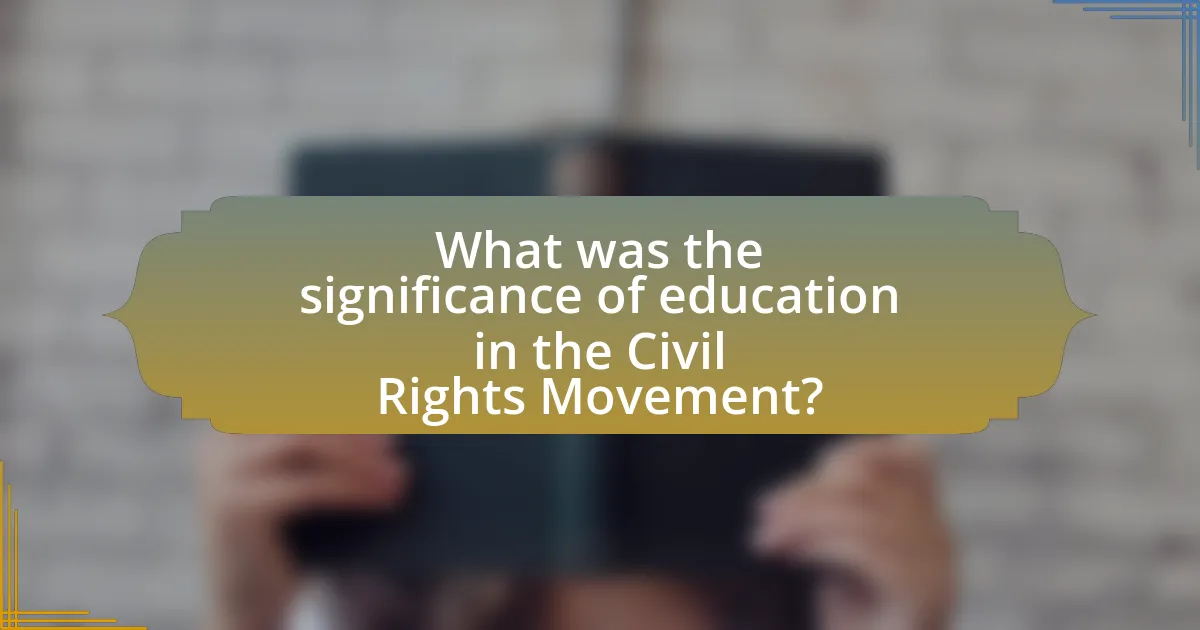
What was the significance of education in the Civil Rights Movement?
Education played a crucial role in the Civil Rights Movement by empowering individuals and fostering a sense of agency among African Americans. It served as a tool for social change, enabling activists to challenge systemic racism and advocate for equal rights. For instance, the establishment of historically black colleges and universities (HBCUs) provided a foundation for leadership training and political activism, producing influential figures such as Martin Luther King Jr. and Thurgood Marshall. Additionally, the integration of public schools, highlighted by the landmark Brown v. Board of Education decision in 1954, was pivotal in dismantling segregation and promoting equality in education. This legal victory underscored the importance of education as a means to achieve civil rights, demonstrating that access to quality education was essential for social justice and equality.
How did education serve as a tool for social change during the Civil Rights Movement?
Education served as a crucial tool for social change during the Civil Rights Movement by empowering individuals with knowledge and fostering critical thinking. Educational initiatives, such as the establishment of Freedom Schools, aimed to provide African Americans with a quality education that was often denied to them in segregated schools. These schools not only taught academic subjects but also emphasized civil rights awareness, encouraging students to engage in activism. For instance, the Freedom Schools in Mississippi during the summer of 1964 enrolled thousands of students and taught them about their rights, history, and the importance of voting, which directly contributed to increased voter registration among African Americans. This educational approach helped to cultivate a generation of leaders who were informed and motivated to challenge systemic racism and advocate for equality.
What role did historically Black colleges and universities play in the movement?
Historically Black colleges and universities (HBCUs) played a crucial role in the Civil Rights Movement by serving as centers for activism, education, and leadership development. These institutions provided a space for Black students to engage in political activism, organize protests, and develop strategies for civil rights advocacy. For example, students from HBCUs such as North Carolina A&T State University were instrumental in the Greensboro sit-ins of 1960, which challenged segregation at lunch counters. Additionally, HBCUs produced influential leaders like Martin Luther King Jr. and Ella Baker, who were pivotal in shaping the movement’s direction and philosophy. The educational environment at HBCUs fostered a sense of community and empowerment, equipping students with the skills and knowledge necessary to confront racial injustice.
How did educational initiatives empower African American communities?
Educational initiatives empowered African American communities by providing access to quality education, which fostered leadership, civic engagement, and economic opportunities. Programs such as the establishment of historically Black colleges and universities (HBCUs) and initiatives like the Freedom Schools during the Civil Rights Movement equipped individuals with the knowledge and skills necessary to challenge systemic racism and advocate for civil rights. For instance, HBCUs produced a significant number of African American leaders, including Martin Luther King Jr. and Thurgood Marshall, who played pivotal roles in the movement. Furthermore, the literacy programs aimed at combating voter suppression in the 1960s helped increase voter registration among African Americans, thereby enhancing their political power and influence.
Why was access to quality education a central issue in the Civil Rights Movement?
Access to quality education was a central issue in the Civil Rights Movement because it was seen as a fundamental right that was systematically denied to African Americans. The landmark case Brown v. Board of Education in 1954 declared racial segregation in public schools unconstitutional, highlighting the importance of equal educational opportunities. This case underscored the belief that education was essential for social and economic advancement, and the lack of access to quality education perpetuated cycles of poverty and inequality. Furthermore, the Civil Rights Movement aimed to dismantle institutional barriers that prevented African Americans from receiving the same educational resources and opportunities as their white counterparts, making education a pivotal battleground for achieving civil rights and social justice.
What were the disparities in educational resources between Black and white schools?
Disparities in educational resources between Black and white schools were significant, with Black schools often receiving less funding, inferior facilities, and fewer qualified teachers. For instance, during the 1950s, Black schools in the South typically received about half the funding per student compared to white schools, leading to overcrowded classrooms and inadequate materials. This funding gap was a direct result of systemic racism and discriminatory policies, which perpetuated educational inequality and limited opportunities for Black students. Historical data from the U.S. Commission on Civil Rights in 1961 highlighted these disparities, showing that Black schools were often located in dilapidated buildings and lacked essential resources such as libraries and laboratories, further exacerbating the educational divide.
How did segregation in education impact civil rights activism?
Segregation in education significantly fueled civil rights activism by highlighting systemic inequalities and galvanizing communities to demand change. The landmark case Brown v. Board of Education in 1954 declared racial segregation in public schools unconstitutional, serving as a catalyst for the civil rights movement. This ruling not only challenged the legal framework supporting segregation but also inspired grassroots activism, as African Americans organized protests, sit-ins, and marches to advocate for equal educational opportunities. The disparities in educational resources and quality between segregated schools underscored the broader injustices faced by African Americans, motivating leaders like Martin Luther King Jr. and organizations such as the NAACP to mobilize for civil rights reforms.
What strategies were employed to promote educational equality?
Strategies employed to promote educational equality included legal challenges, grassroots organizing, and federal legislation. Legal challenges, such as Brown v. Board of Education in 1954, aimed to dismantle segregation in public schools, establishing that separate educational facilities are inherently unequal. Grassroots organizing involved community efforts, such as the formation of organizations like the NAACP and the Southern Christian Leadership Conference, which mobilized local communities to demand equal access to quality education. Federal legislation, notably the Elementary and Secondary Education Act of 1965, provided funding to schools serving low-income students, addressing disparities in educational resources. These strategies collectively aimed to create a more equitable educational landscape during the Civil Rights Movement.
How did grassroots organizations influence educational reform?
Grassroots organizations significantly influenced educational reform by mobilizing communities to advocate for equitable access to quality education. These organizations, such as the Student Nonviolent Coordinating Committee (SNCC) and the Southern Christian Leadership Conference (SCLC), organized protests, voter registration drives, and community education initiatives that highlighted systemic inequalities in the education system. For instance, the 1964 Civil Rights Act, which aimed to eliminate discrimination in education, was largely propelled by grassroots activism that brought national attention to the disparities faced by African American students. Additionally, grassroots efforts led to the establishment of Freedom Schools during the Civil Rights Movement, which provided alternative education focused on civil rights and empowerment, demonstrating the direct impact of community-led initiatives on educational reform.
What role did legal challenges play in advancing educational rights?
Legal challenges were instrumental in advancing educational rights by dismantling discriminatory practices and ensuring equal access to quality education for marginalized groups. Landmark cases such as Brown v. Board of Education in 1954 declared racial segregation in public schools unconstitutional, setting a precedent that challenged systemic inequalities. This ruling not only mandated the desegregation of schools but also galvanized further legal actions and civil rights activism aimed at achieving educational equity. The impact of these legal challenges is evidenced by subsequent legislation, such as the Civil Rights Act of 1964, which reinforced the commitment to eliminate discrimination in education, thereby promoting a more inclusive educational environment.
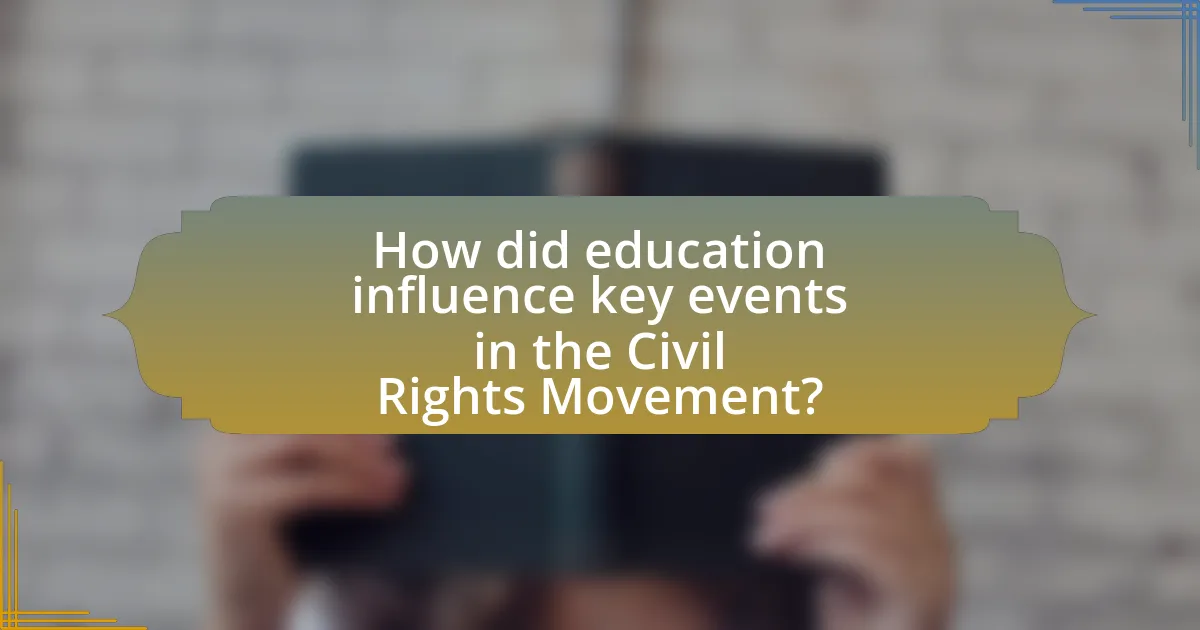
How did education influence key events in the Civil Rights Movement?
Education significantly influenced key events in the Civil Rights Movement by empowering individuals with knowledge and fostering activism. For instance, the establishment of historically Black colleges and universities (HBCUs) provided a platform for African Americans to gain higher education and develop leadership skills. Notably, students from HBCUs played crucial roles in events like the Greensboro sit-ins in 1960, where educated youth organized nonviolent protests against segregation. Furthermore, the Civil Rights Act of 1964, which aimed to eliminate discrimination in education, was a direct result of the advocacy and awareness raised by educated activists. This connection between education and activism illustrates how educational institutions served as incubators for civil rights leaders and strategies, ultimately shaping the trajectory of the movement.
What impact did the Brown v. Board of Education decision have on the movement?
The Brown v. Board of Education decision significantly advanced the Civil Rights Movement by declaring racial segregation in public schools unconstitutional. This landmark ruling provided a legal foundation for challenging segregation and discrimination, inspiring activists to pursue further civil rights reforms. The decision mobilized grassroots efforts and increased public awareness, leading to subsequent actions such as the Montgomery Bus Boycott and the formation of organizations like the Southern Christian Leadership Conference. The ruling’s impact was evident as it catalyzed a nationwide push for desegregation and equality, ultimately contributing to the passage of the Civil Rights Act of 1964.
How did this landmark case change the landscape of public education?
The landmark case Brown v. Board of Education fundamentally changed the landscape of public education by declaring racial segregation in public schools unconstitutional. This 1954 Supreme Court decision overturned the precedent set by Plessy v. Ferguson, which upheld the “separate but equal” doctrine, thereby mandating the desegregation of schools across the United States. The ruling provided a legal foundation for challenging segregation and discrimination, leading to increased enrollment of African American students in previously all-white schools and fostering a more inclusive educational environment. The case also galvanized the Civil Rights Movement, inspiring further actions and legislation aimed at achieving equality in education and other public spheres.
What were the immediate and long-term effects of this ruling on civil rights activism?
The immediate effect of the ruling on civil rights activism was the mobilization of grassroots organizations, which intensified efforts to challenge segregation and discrimination. Activists quickly organized protests, voter registration drives, and legal challenges to enforce the ruling, exemplified by the increased activity of groups like the NAACP and the Southern Christian Leadership Conference.
In the long term, the ruling catalyzed significant legislative changes, including the Civil Rights Act of 1964 and the Voting Rights Act of 1965, which dismantled institutional barriers to equality. These laws were a direct response to the activism spurred by the ruling, leading to a sustained movement that transformed societal norms and legal frameworks regarding civil rights in the United States.
How did student activism shape the Civil Rights Movement?
Student activism significantly shaped the Civil Rights Movement by mobilizing young people to challenge racial segregation and injustice. Organizations like the Student Nonviolent Coordinating Committee (SNCC), founded in 1960, played a crucial role in organizing sit-ins, freedom rides, and voter registration drives, which directly confronted discriminatory practices. For instance, the Greensboro sit-ins in 1960, initiated by four African American college students, sparked a nationwide wave of similar protests, demonstrating the power of youth-led initiatives in advocating for civil rights. This activism not only raised awareness but also pressured political leaders to enact change, contributing to landmark legislation such as the Civil Rights Act of 1964 and the Voting Rights Act of 1965.
What were the contributions of student-led organizations like SNCC?
Student-led organizations like the Student Nonviolent Coordinating Committee (SNCC) significantly contributed to the Civil Rights Movement by mobilizing youth activism and advocating for voter registration among African Americans. SNCC organized sit-ins, freedom rides, and voter registration drives, which were pivotal in challenging segregation and disenfranchisement. For instance, the 1960 Greensboro sit-ins initiated by SNCC members led to the desegregation of lunch counters across the South. Additionally, SNCC played a crucial role in the 1964 Freedom Summer campaign, which aimed to increase voter registration in Mississippi, resulting in the registration of thousands of African Americans. These actions not only raised awareness but also empowered a generation to fight for civil rights, demonstrating the effectiveness of grassroots organizing in achieving social change.
How did educational protests, such as sit-ins, mobilize communities?
Educational protests, such as sit-ins, mobilized communities by fostering collective action and raising awareness about racial injustices in educational institutions. These protests served as a catalyst for community engagement, as individuals from diverse backgrounds came together to challenge segregation and demand equal access to education. For instance, the Greensboro sit-ins in 1960 involved African American students who peacefully occupied segregated lunch counters, which not only drew national attention but also inspired similar actions across the country, leading to a broader civil rights movement. The sit-ins demonstrated the power of nonviolent resistance and encouraged community solidarity, ultimately contributing to significant legislative changes, such as the Civil Rights Act of 1964, which aimed to eliminate discrimination in public spaces, including schools.
What role did education play in the development of civil rights leaders?
Education played a crucial role in the development of civil rights leaders by equipping them with the knowledge, critical thinking skills, and rhetorical abilities necessary to advocate for social justice. Many prominent civil rights leaders, such as Martin Luther King Jr. and Malcolm X, pursued higher education, which provided them with a deeper understanding of social, political, and economic issues affecting African Americans. For instance, King earned a doctorate in systematic theology from Boston University, which not only shaped his philosophical outlook but also enhanced his ability to articulate the moral imperative for civil rights. Additionally, educational institutions served as platforms for organizing and mobilizing efforts, as seen in the establishment of groups like the Student Nonviolent Coordinating Committee (SNCC), which was founded by college students committed to nonviolent protest. This combination of formal education and grassroots activism was instrumental in shaping the strategies and ideologies of civil rights leaders, ultimately contributing to the success of the movement.
How did educational backgrounds influence the leadership styles of figures like Martin Luther King Jr.?
Educational backgrounds significantly influenced the leadership styles of figures like Martin Luther King Jr. King’s education at Morehouse College, Crozer Theological Seminary, and Boston University equipped him with critical thinking skills, theological insights, and a deep understanding of social justice. His exposure to diverse philosophical and ethical frameworks, particularly the teachings of Mahatma Gandhi and the principles of nonviolent resistance, shaped his approach to leadership, emphasizing moral authority and peaceful protest. King’s academic experiences fostered his ability to articulate complex ideas and mobilize communities, which were essential in his role as a leader in the Civil Rights Movement.
What was the significance of education in the training of activists?
Education was significant in the training of activists as it equipped them with critical thinking skills, historical context, and strategies for effective advocacy. This foundational knowledge enabled activists to articulate their demands, understand systemic injustices, and mobilize communities. For instance, organizations like the Student Nonviolent Coordinating Committee (SNCC) emphasized education to prepare young leaders for grassroots organizing, fostering a generation capable of challenging segregation and discrimination. The integration of educational programs, such as Freedom Schools during the Civil Rights Movement, further demonstrated the role of education in empowering individuals to engage in social change effectively.
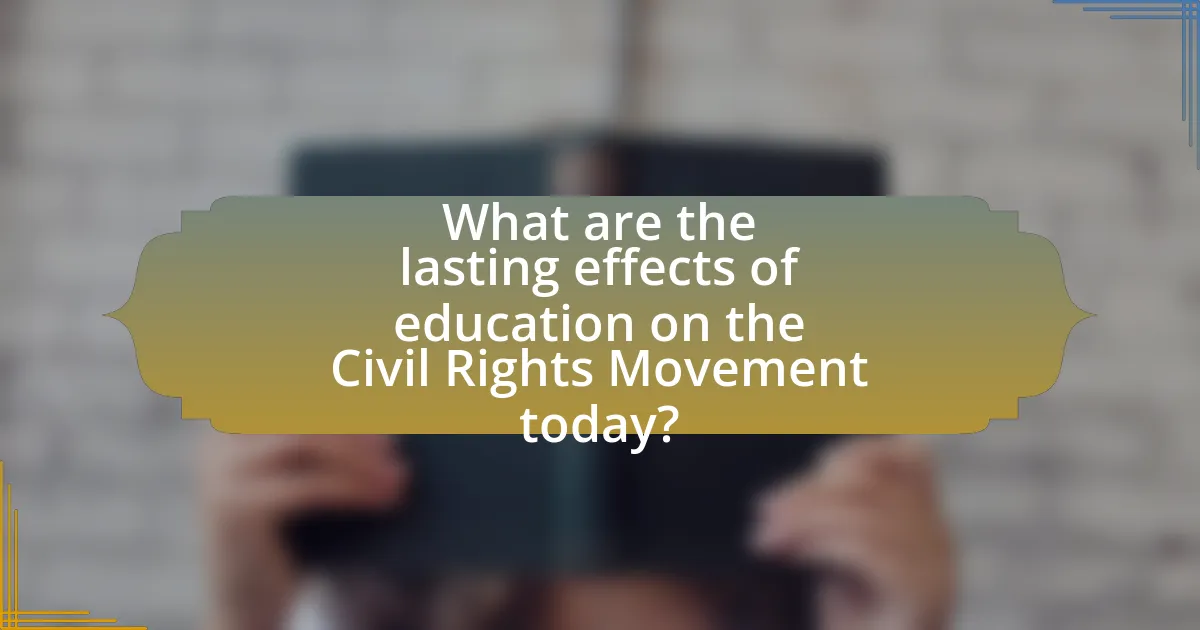
What are the lasting effects of education on the Civil Rights Movement today?
Education has a lasting impact on the Civil Rights Movement today by fostering awareness and understanding of social justice issues. This educational foundation has led to increased civic engagement and advocacy for equality, as seen in contemporary movements like Black Lives Matter, which draw on historical lessons from the Civil Rights Movement. Furthermore, educational initiatives, such as multicultural curricula and diversity training, promote inclusivity and challenge systemic racism, reinforcing the principles of equality and justice established during the Civil Rights era. These effects are evidenced by the ongoing efforts to address racial disparities in education and employment, highlighting the critical role education plays in sustaining the movement’s legacy.
How has the legacy of the Civil Rights Movement influenced modern educational policies?
The legacy of the Civil Rights Movement has significantly influenced modern educational policies by promoting equity and access in education. Landmark legislation such as the Elementary and Secondary Education Act of 1965 emerged from the movement’s advocacy for equal educational opportunities, aiming to eliminate disparities based on race and socioeconomic status. Additionally, the movement’s emphasis on desegregation led to policies that enforce diversity and inclusion within schools, ensuring that all students, regardless of their background, receive a quality education. This historical context is evident in ongoing initiatives that address systemic inequalities, such as affirmative action and funding reforms aimed at under-resourced schools, reflecting the movement’s enduring impact on shaping educational equity today.
What current challenges in education reflect the issues faced during the Civil Rights Movement?
Current challenges in education that reflect issues faced during the Civil Rights Movement include systemic inequities, segregation, and access to quality resources. For instance, schools in predominantly minority neighborhoods often receive less funding, leading to disparities in educational quality, similar to the unequal funding and resources that characterized segregated schools during the Civil Rights era. According to the U.S. Department of Education, schools serving low-income students receive about $1,000 less per student than those serving affluent populations, highlighting ongoing financial inequities. Additionally, the prevalence of disciplinary actions disproportionately affecting students of color mirrors the discriminatory practices that were challenged during the Civil Rights Movement, where minority students faced harsher treatment compared to their white peers. These persistent issues underscore the continuing struggle for educational equity that echoes the historical fight for civil rights.
How do contemporary movements draw inspiration from the educational strategies of the past?
Contemporary movements draw inspiration from the educational strategies of the past by implementing grassroots organizing, community education, and advocacy for equitable access to education. For instance, the Civil Rights Movement utilized Freedom Schools to empower African American communities through education, fostering critical thinking and civic engagement. Modern movements, such as Black Lives Matter, adopt similar approaches by emphasizing the importance of education in raising awareness about social justice issues and mobilizing communities. Historical evidence shows that these educational strategies not only informed activists but also created a framework for collective action, demonstrating their lasting impact on contemporary advocacy efforts.
What lessons can be learned from the role of education in the Civil Rights Movement?
The role of education in the Civil Rights Movement teaches that access to quality education is essential for social change and empowerment. Education served as a critical tool for African Americans to challenge systemic racism and advocate for their rights, exemplified by initiatives like the Freedom Schools established during the 1964 Freedom Summer, which aimed to educate Black students and increase voter registration. Furthermore, landmark cases such as Brown v. Board of Education in 1954 highlighted the importance of dismantling segregated schooling as a means to achieve equality. These historical examples demonstrate that education can mobilize communities, raise awareness, and foster leadership, ultimately contributing to the advancement of civil rights.
How can current educational initiatives promote social justice and equality?
Current educational initiatives can promote social justice and equality by implementing inclusive curricula that reflect diverse histories and perspectives. For instance, programs that integrate the study of civil rights movements and the contributions of marginalized groups foster understanding and empathy among students. Research shows that when students learn about the struggles and achievements of various communities, such as the African American civil rights movement, they are more likely to develop a sense of social responsibility and advocacy for equity. Additionally, initiatives that provide access to resources and support for underrepresented students, such as mentorship programs and scholarships, help to level the playing field, thereby contributing to a more equitable educational landscape.
What best practices can be derived from historical educational efforts in civil rights activism?
Best practices derived from historical educational efforts in civil rights activism include community engagement, curriculum development focused on social justice, and the use of grassroots organizing. Community engagement was exemplified by initiatives like the Freedom Schools during the 1964 Freedom Summer, which educated African American students about their rights and history, fostering a sense of empowerment. Curriculum development that emphasizes social justice can be seen in the work of organizations like the Southern Christian Leadership Conference, which integrated civil rights education into schools to raise awareness and inspire activism. Grassroots organizing, as demonstrated by the Student Nonviolent Coordinating Committee, highlighted the importance of mobilizing young people through education to create change. These practices have proven effective in building awareness, fostering leadership, and promoting active participation in civil rights movements.
How can individuals contribute to educational equity today?
Individuals can contribute to educational equity today by actively supporting policies and initiatives that promote equal access to quality education for all students. Engaging in advocacy efforts, such as contacting local representatives to support funding for under-resourced schools, can directly impact educational opportunities. Research indicates that equitable funding can significantly improve student outcomes; for instance, the Education Trust found that schools serving low-income students receive about $1,000 less per student than those serving wealthier populations. Additionally, volunteering as a mentor or tutor in underserved communities helps bridge educational gaps, fostering a more inclusive learning environment.
